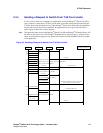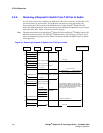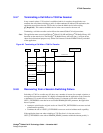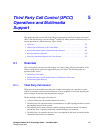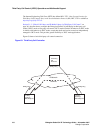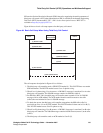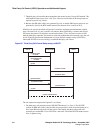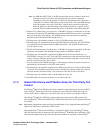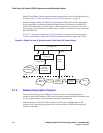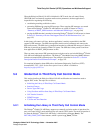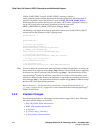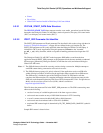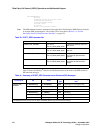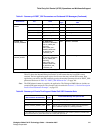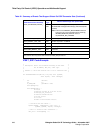Dialogic
®
Global Call IP Technology Guide — November 2007 341
Dialogic Corporation
Third Party Call Control (3PCC) Operations and Multimedia Support
Note: Per SDP rules (RFC 3264), if an SDP message body does not contain a media level
description (at least one m line), the message body must contain connection
information (c line must be present). To satisfy this requirement in IPv4 networks, a
“black hole” IP address of 0.0.0.0 is provided as part of the c line in the SDP message
body. IPv4 packets sent to this “black hole” address never leave the host that sent
them; the packets are discarded. Keep in mind that this behavior is specific to IPv4
networks. IPv6 and other networks should use an IP address with similar properties.
2. When User A’s phone rings, User A answers. A 200 OK (2) message is sent from User A to the
third party call controller. The 200 OK message contains an SDP answer (answer1) to the third
party call controller’s offer (offer1). The 200 OK message does not provide a media level
description, much like the INVITE method from (1).
3. The third party call controller responds to User A’s 200 OK message with an ACK.
4. The third party call controller then sends an INVITE method to User B (4). This INVITE does
not contain Session Description Protocol (SDP) information. This INVITE method causes
User B’s phone to ring.
5. When User B’s phone rings, User B answers. A 200 OK (5) message is sent from User B to the
third party call controller. The 200 OK message contains an SDP offer (offer2).
6. The third party call controller encapsulates the SDP offer from User B (offer2) into a re-
INVITE that is sent to User A (6). The re-INVITE is based on the offer received from User B
(offer2). The only difference between offer2' and offer2 is that the origin line (o line) in offer2'
must be valid based on the o line in offer2.
7. User A responds with a 200 OK message (7). This message contains an answer (answer2') to
the third party call controller’s re-INVITE offer (offer2').
8. The third party call controller encapsulates the SDP answer from User A into an ACK method
(answer2). The only difference between answer2 and answer2 is that the origin line (o line) in
answer2' must be valid based on the o line in answer2. The ACK is sent to User B (8).
9. The third party call controller sends an ACK method to User A (9).
10. The RTP (media stream) flows between User A and User B (10).
5.1.2 Global Call Library and IP Media Library for Third Party Call
Control
The Dialogic
®
Global Call API library has been extended to support third party call control (3PCC)
mode. Dialogic
®
Global Call API can be configured to run in either the default first party call
control mode (1PCC) or third party call control mode. The two modes are mutually exclusive.
The Dialogic
®
Global Call API library supports third party call control for SIP networks only.
When the Dialogic
®
Global Call API library is initialized in 3PCC mode, H.323 operations will not
be available.
Note: Multimedia (simultaneous audio and video) record/playback is only supported when the Dialogic
®
Global Call API library is initialized in 3PCC mode.
When the Dialogic
®
Global Call API library is initialized in 1PCC mode, the Dialogic
®
Global
Call API library provides an abstraction layer for the Dialogic
®
IP Media Library API library. This
allows the host application to open and close IP media channels for streaming via the Dialogic
®



